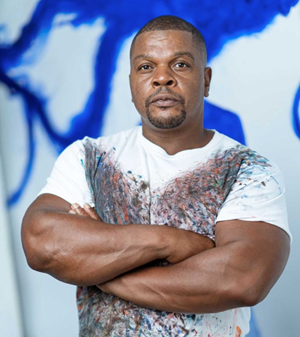
This winter, in his first collaboration with a major UK gallery, American artist Kehinde Wiley will explore the artistic conventions and canons of the Western landscape tradition – mountainous, coastal, sublime, Romantic and transcendental – through the mediums of film and painting.
This winter, in his first collaboration with a major UK gallery, American artist Kehinde Wiley will explore the artistic conventions and canons of the Western landscape tradition – mountainous, coastal, sublime, Romantic and transcendental – through the mediums of film and painting.
Kehinde Wiley (b. 1977, Los Angeles) is an American artist best known for his portraits that feature people of colour in the traditional settings of Old Master paintings. Most famously, in 2017 he was commissioned to paint Barack Obama, becoming the first Black artist to paint an official portrait of a President of the United States. His work references European portraiture by positioning contemporary Black sitters, from a range of ethnic and social backgrounds, often wearing casual or hip-hop clothing, in the poses of the original historical, religious or mythological figures, conferring – in the process – his sitters with a similar fame and status.
His images – as part quotation, part intervention – raise questions about power, privilege, identity, and above all highlight the absence or marginalisation of Black figures within European art.
Wiley’s first film installation, 'Narrenschiff' (2017), was a contemporary response to the ‘Ship of Fools’ allegory, popular in European culture from the late 15th century. Wiley’s work featured a group of young Black men at sea, struggling to reach the land – a metaphor for both historical and contemporary issues of migration, isolation and social dislocation.
Building on these themes at the National Gallery, with five paintings and one six-channel digital film, Wiley will explore European Romanticism and its focus on epic scenes of oceans and mountains, humankind’s relationship with nature and in the process touches upon current concerns such as climate change and migration.
One section of the film included in this project will feature Black Londoners that Wiley met and cast for the film on the streets around the National Gallery, and whom he took on a trip to Norway to explore its fjords and glacial landscapes. Mountains can be perceived as something to be conquered. They can also be seen as impenetrable places, the highest places on earth and consequently the closest to the heavens, associated with virtue, rationality, purity and godliness. In this film 'In Search of the Miraculous' the Black female and male characters are, in turns, overwhelmed by the snow, subsumed by whiteness and almost disappear in the landscape, or take centre stage and contemplate nature in a respectful and dignified way. His paintings reference the Romantic wanderer figure in search of spirituality or self-discovery.
Marine painting has long been linked to European maritime power and traditionally featured imperial endeavours, voyages of exploration, and typically emphasized the prowess of experienced seafarers or the bravery and leadership qualities of (white) naval officers. In Wiley’s work, oceans are seen as changing, irrational and unreliable forces which also can be used as trade routes, passages and escapes to a better life, and also represent the site of a defunct empire.
Situated in the Sunley Room, at the centre of the Gallery’s collection, this free exhibition will draw out the dynamic relationship between Wiley’s work and the National Gallery’s historical landscapes and seascapes by artists such as Claude, Friedrich, Turner and Vernet.
Christine Riding, Jacob Rothschild Head of the Curatorial Department, says: ‘I met Kehinde Wiley in 2017, as a curator at the Royal Museums Greenwich, when we acquired his allegorical painting, 'Ship of Fools', the first work by this internationally renowned artist to enter a UK public collection. I am so thrilled to have the opportunity to collaborate with him at the National Gallery, building on his recent exploration of the pictorial conventions associated in Western art with the sublime, landscape and marine art.’
National Gallery Director, Dr Gabriele Finaldi, says: ‘The National Gallery’s paintings and the themes they explore have archetypal status and seem to demand constant reconsideration and reinterpretation. Kehinde Wiley’s response has been to define a new kind of sublime, one that is strong and distinctive, that reflects on artistic and poetic tradition, but confronts urgent contemporary questions of identity, migration and marginality.’
The exhibition takes place at Sunley Room 10 from December 2021 – 18 April 2022
More information at nationalgallery.org.uk

ArtDependence Magazine is an international magazine covering all spheres of contemporary art, as well as modern and classical art.
ArtDependence features the latest art news, highlighting interviews with today’s most influential artists, galleries, curators, collectors, fair directors and individuals at the axis of the arts.
The magazine also covers series of articles and reviews on critical art events, new publications and other foremost happenings in the art world.
If you would like to submit events or editorial content to ArtDependence Magazine, please feel free to reach the magazine via the contact page.